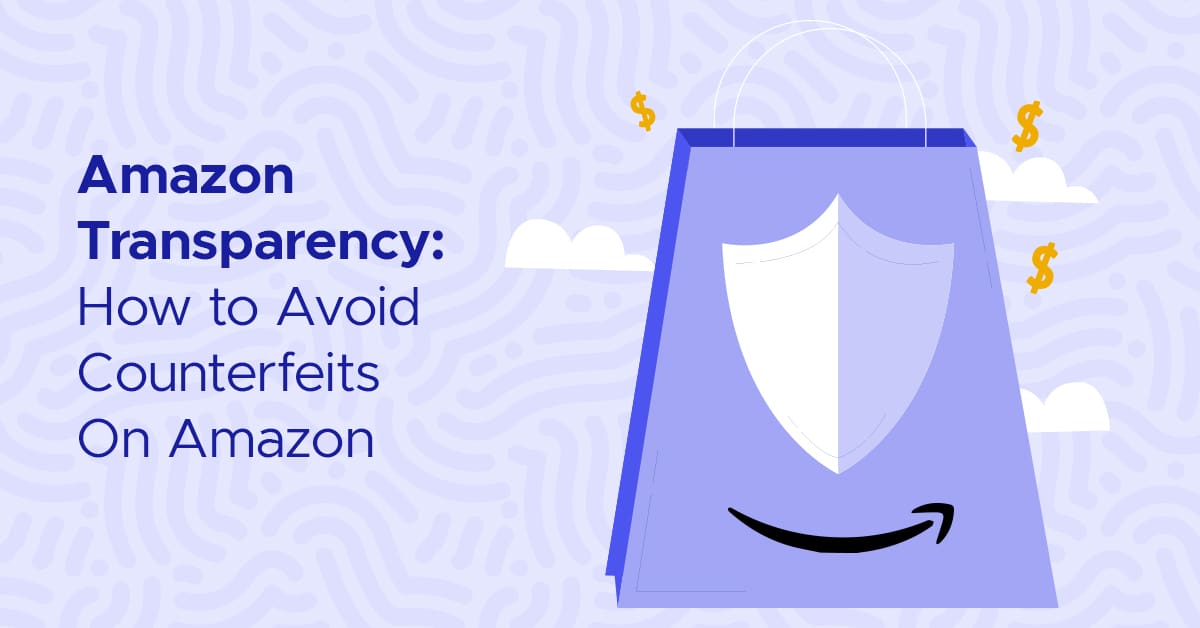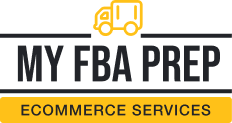
Amazon Transparency: How to Avoid Counterfeits on Amazon

Selling on Amazon is viewed as a major opportunity for entrepreneurs. That’s a legitimate assessment, considering the platform attracts over three billion monthly users and generates $1.59 billion in daily sales.
However, the eCommerce marketplace also comes with risks; in 2023 alone, Amazon found, seized, and discarded over seven million counterfeit items. As the counterfeiting problem continues to grow, Amazon has rolled out several programs and tools to help tackle fraud and give brands more control over their listings.
This article explores one such initiative, the Amazon Transparency program. It’ll explain what it is, how it works, and how it can safeguard your eCommerce brand.
What is Amazon Transparency?
In Amazon’s Transparency program, every product is issued a unique, two-dimensional QR code called a Transparency code that can be scanned through the Amazon app to confirm the item’s authenticity. As of this article’s writing, it’s only available to Amazon stores in Australia, Canada, France, Germany, Italy, Spain, the UK, and the U.S.
Launched in 2017, the service protects buyers and sellers by keeping fake goods out of the marketplace. Additionally, Amazon recently introduced interoperability into the Transparency program. The update lets brands use their existing serialization systems instead of relying solely on Amazon-issued codes. This advancement simplifies the enrollment process, reduces costs, and accelerates brand protection for when you need it most.
Enrolling in Amazon Transparency
You must meet the eligibility requirements to enroll your brand and products in Amazon’s Transparency program. Specifically, you’ll need:
- An Amazon Brand Registry account
- A registered trademark for your brand
- A valid Global Trade Item Number (GTIN)
Once you’ve satisfied these criteria, there are three easy ways to implement the Transparency program for your products:
- Print and apply Amazon-issued Transparency codes or collaborate with a service provider that specializes in Transparency to handle the labels. You can choose between standard and custom label options.
- Incorporate Transparency codes into your packaging design to make the process seamless and professional.
- Connect Transparency to your existing serialization system so you can use the setup you already have.
Your products then undergo an operational performance review (OPR). This process verifies that each unit has either an Amazon-issued Transparency code or another existing serial code. Once your products pass the review, Transparency protection activates to safeguard your items against counterfeits.
5 Best practices for incorporating Transparency codes
Amazon’s Transparency codes are flexible enough to accommodate various items and printing methods. When scanned using the Amazon app, these unique codes confirm a product’s authenticity, giving both sellers and buyers peace of mind. The following five tips will help you make the most of the program:
- Ensure optimal code size and placement: The code should be large enough to scan easily, even with mobile devices. Place it on a flat, smooth surface to avoid distortions during application.
- Use high-contrast labeling: Choose a label design with a strong contrast between the code and the background to enhance scanning accuracy.
- Opt for waterproof and damage-resistant labels: Use durable materials to prevent smudging, tearing, and fading. This is especially important for products exposed to moisture or rough handling during transit.
- Strategically place codes for multi-packs: Ensure each unit in a multi-pack has its own Transparency code. Place the codes where they’re accessible without unsealing or damaging the packaging.
- Test scannability regularly: Test the codes to confirm they’re easily scannable before shipping. Regular quality checks help avoid issues during Amazon’s verification process.
How Amazon verifies Transparency codes
As of 2023, more than 33,000 brands participate in Amazon’s Transparency program, and the marketplace has verified over 900 million items worldwide. Amazon certifies product authenticity through:
- Unique product codes: Every product in the Transparency program has a special code (a 2D Data Matrix barcode) applied to it or its packaging.
- Listing check: When a product is listed on Amazon, the Transparency system checks the code to verify it’s authentic before it’s shipped to customers so only real products make it to buyers’ doors.
- Easy tracking: Amazon has added impressive features like batch tracking, which helps brands trace supply chain issues, keep shipments on track, and ensure only genuine products are delivered.
- Simple integration: Brands can apply their own serial numbers for product verification without adding an extra Transparency code. These serial numbers are validated whenever a product is sold on Amazon.
- Quick setup: If a brand already uses serial numbers, they can jump into the program quickly. They’re able to enjoy benefits within two weeks without changing their manufacturing or packaging process.
Leverage Amazon Transparency for brand enhancement
The heart of Amazon’s Transparency program is the desire to give every product on the marketplace a guaranteed badge of authenticity. Not only does it combat counterfeits, it also helps brands connect more meaningfully with their customers.
Take Belkin and Logitech, for example — these tech giants have embraced Transparency’s new features by blending their existing serial numbers with Amazon’s unique codes, which streamlines their operations and amplifies customer trust:
- Belkin integrates Transparency codes to ensure every gadget meets high safety and authenticity standards. They serve as pledges of verified quality, promising every purchase is safe, certified, and as real as it gets.
Salim Hijazi, senior channel product manager at Belkin International, says, “By allowing us to use our own codes with Transparency, Amazon furthers our commitment to protecting our customers in a more responsible way.”
- Logitech’s strategy is equally compelling. Integrating Transparency into their global supply chain has not only simplified their processes but also fortified their customer connections. Each Logitech item carries a promise of genuineness from the assembly line to buyers’ hands.
These applications show how the Transparency program is more than a tool against fakes — it’s also a powerful asset for building trust and loyalty. When brands join forces with Amazon, they protect their offerings while enhancing the customer experience, making every purchase a credible transaction.
7 Ways to safeguard your products from counterfeiters
In addition to the Transparency program, there are several other ways to safeguard your brand on Amazon. These initiatives complement Transparency to reinforce your protective measures and create a more secure environment for your products on the platform.
1. Adopt Amazon’s Project Zero
Project Zero is a free, self-service tool for removing counterfeit listings. It integrates seamlessly with Amazon’s other programs, making it a powerful addition to your brand protection strategy.
To ensure proper use of the tool though, Amazon requires users to complete training on Project Zero and undergo ongoing monitoring to continue to receive access. Additionally, users must maintain a 99% accuracy rate when removing listings.
2. Monitor and evaluate your listings regularly
You can’t simply set up protective measures and then forget about them. While tools can help spot counterfeits, you need a human touch to catch discrepancies in the finer details, especially with listings.
Clear, high-quality images and detailed descriptions will make your listings stand out. It also makes it tougher for counterfeiters to replicate your products. You can set up alerts and regularly check Seller Central to detect unauthorized sellers early.
3. Source products from verified suppliers
Cover all bases when it comes to your suppliers. Only work with verified companies and develop a clear contract for all parties involved. This extra legal protection will help keep operations running smoothly as you source your products or materials.
4. Track your supply chain
Another way to protect your products from fraud is by closely monitoring your supply chain. A real-time tracking system like inventory management software gives you complete visibility and transparency at every stage of the process.
5. Work with trusted logistics providers
A simpler, more effective way to prioritize your brand’s protection is to partner with a trusted logistics provider. They possess the knowledge and expertise needed to safeguard your brand from fraud. You also gain access to experienced Amazon professionals equipped to handle the marketplace’s complexities so you can worry less and focus more on scaling your business.
6. Educate customers about counterfeits
With counterfeits popping up even on platforms like Amazon, giving your customers the tools to identify the real deal makes them far less likely to be tricked.
Simplify it for them by pointing out key characteristics to check, like:
- Packaging details
- Your logo
- A list of your brand’s authorized sellers
You can even go the extra mile and show a side-by-side comparison of a real product versus a fake one to highlight what sets the authentic item apart.
7. Protect your intellectual property
Protecting your intellectual property (IP) doesn’t have to break the bank. But you first need to know the difference between a patent, a copyright, and a trademark:
- Patents protect useful inventions.
- Copyrights cover creative works like books.
- Trademarks safeguard things like your brand name or logo.
Each IP protection has a unique role, so if you’re unsure what’s best for your business, seek out IP experts for assistance.
Wrapping up — Maintain your brand’s integrity amid counterfeit risks
With the upgraded Transparency program, protecting your brand on Amazon is easier, more affordable, and more effective. Beyond helping you fight counterfeits though, it streamlines your processes, strengthens customer relationships, and builds trust in your brand.
Transparency can bring numerous benefits to your business, from improved inventory management to greater consumer satisfaction. However, you need to implement this service correctly to unlock all its advantages.
That’s where MyFBAPrep steps in. As Amazon experts, we stay on top of all the latest programs on the platform, including Transparency, so we can guide you through every step. Our team is equipped with comprehensive knowledge and expertise to help you navigate the complexities of the marketplace.
Ready to get started? Connect with us to discuss how we can help your brand.
